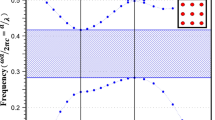Abstract
A novel passive all-optical full subtractor device is realized using a two-dimensional (2-D) photonic crystal. The proposed structure is realized using the concept of beam interference in a sequence of T- and Y-shaped line-defective waveguide structures made of a linear material such as silicon with air as the background medium. The major advantage of this design approach is the avoidance of nonlinear materials and semiconductor optical amplifiers. In addition to the actual input ports, some reference input ports are also utilized to achieve the desired full subtractor functionality. The different input combinations to the full subtractor are given and optimized via several simulations. The full subtractor functionality is validated using the Opti-FDTD tool. The simulation results for the full subtractor are supported by the E-field distribution and power analysis at the output ports for different input logic values at a wavelength around 1550 nm. The proposed structure shows a fast response time of 0.16 ps, a bit rate of 6.25 Tbps, and a contrast ratio of 3.97 dB, and occupies an area of 465 µm2.













Similar content being viewed by others
References
Joannopoulos, J.D., Villeneuve, P.R., Fan, S.: Photonic crystals: putting a new twist on light. Nature 386(6621), 143–149 (1997)
Yablonovitch, E.: Photonic crystals: semiconductors of light. Sci. Am. 285, 46–55 (2001)
Liu, C.C., Wu, C.J.: Analysis of a defect mode in a dielectric photonic crystal containing ITO defect. Optik 125(24), 7140–7142 (2014)
Li, H., Yang, X.: Larger absolute band gaps in two-dimensional photonic crystals fabricated by a three-order-effect method. Prog. Electromagn. Res. 108, 385–400 (2010)
Pu, S., Dong, S., Huang, J.: Tunable slow light based on magnetic-fluid-infiltrated photonic crystal waveguides. J. Opt. 16(4), 045102 (2014)
Pu, S., Liu, M.: Tunable photonic crystals based on MnFe2O4 magnetic fluids by magnetic fields. J. Alloys Compd. 481(1–2), 851–854 (2009)
Pu, S., Bai, X., Wang, L.: Temperature dependence of photonic crystals based on thermoresponsive magnetic fluids. J. Magn. Magn. Mater. 323(22), 2866–2871 (2011)
Fu, Y., Hu, X., Gong, Q.: Silicon photonic crystal all-optical logic gates. Phys. Lett. A 377(3–4), 329–333 (2013)
Wu, C.J., Liu, C.P., Ouyang, Z.: Compact and low-power optical logic NOT gate based on photonic crystal waveguides without optical amplifiers and nonlinear materials. Appl. Opt. 51(5), 680–685 (2012)
Hussein, M.E., Ali, T.A., Rafat, N.H.: New designs of a complete set of photonic crystals logic gates. Opt. Commun. 411, 175–181 (2018)
Parandin, F., Malmir, M.-R., Naseri, M.: All-optical half-subtractor with low-time delay based on two-dimensional photonic crystals. Superlattices Microstruct. 109, 437–441 (2017)
Moradi, R.: All optical half subtractor using photonic crystal based nonlinear ring resonators. Opt. Quant. Electron. 51(4), 119 (2019)
Cheraghi, F., Soroosh, M., Akbarizadeh, G.: An ultra-compact all optical full adder based on nonlinear photonic crystal resonant cavities. Superlattices Microstruct. 113, 359–365 (2018)
Jalali-Azizpoor, M.R., Soroosh, M., Seifi-Kavian, Y.: Application of self-collimated beams in realizing all-optical photonic crystal-based half-adder. Photon. Netw. Commun. 36(3), 344–349 (2018)
Alipour-Banaei, H., Seif-Dargahi, H.: Photonic crystal based 1-bit full-adder optical circuit by using ring resonators in a nonlinear structure. Photon. Nanostruct. Fundam. Appl. 24, 29–34 (2017)
Seifouri, M., et al.: Ultra-fast and compact all-optical half adder using 2D photonic crystals. IET Optoelectron. 13(3), 139–143 (2019)
Swarnakar, S., Kumar, S., Sharma, S.: Design of all-optical half-subtractor circuit device using 2-D principle of photonic crystal waveguides. J. Opt. Commun. 40(3), 195–203 (2019)
Swarnakar, S., Kumar, S., Sharma, S.: Performance analysis of all-optical full-adder based on two-dimensional photonic crystals. J. Comput. Electron. 17(3), 1124–1134 (2018)
Shaik, Eh., Rangaswamy, N.: Improved design of all-optical photonic crystal logic gates using T-shaped waveguide. Opt. Quantum Electron. 48(1), 33 (2016)
D’souza, N.M., Mathew, V.: Interference based square lattice photonic crystal logic gates working with different wavelengths. Opt. Laser Technol. 80, 214–219 (2016)
Author information
Authors and Affiliations
Corresponding author
Additional information
Publisher’s Note
Springer Nature remains neutral with regard to jurisdictional claims in published maps and institutional affiliations.
Rights and permissions
About this article
Cite this article
Abhishek, J., Krishnan, P. & Robinson, S. A design for an ultrafast all-optical full subtractor based on two-dimensional photonic crystals. J Comput Electron 20, 433–441 (2021). https://doi.org/10.1007/s10825-020-01637-9
Received:
Accepted:
Published:
Issue Date:
DOI: https://doi.org/10.1007/s10825-020-01637-9




